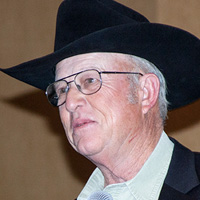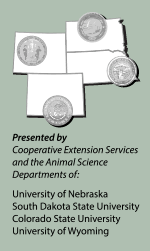Commercial Rancher
Applies GeneMax™
by Troy Smith, field editor, Angus Journal
RAPID CITY, S.D. (Dec. 2, 2013) — Rancher Joe Mayer believes in using all available tools for improving his commercial Angus herd. Speaking during a meeting sponsored by Certified Angus Beef LLC (CAB), Mayer talked about how, following drought-induced herd reduction, he is using DNA testing to rebuild numbers. The meeting was hosted Dec. 2, on the eve of the Range Beef Cow Symposium (RBCS) in Rapid City, S.D.

“We had to decide which of the purchased heifers we would keep for breeding and which we would sell,” said commercial cattleman Joe Mayer, who relayed how he is using GeneMax in his decision-making.
According to Mayer, four years of intensifying drought forced major destocking of his Oklahoma Panhandle operation. Somewhat improved conditions in 2012 prompted the decision to start rebuilding through the purchase of heifer calves. Relief from drought proved short-lived, however, prompting Mayer to rethink his plan for rebuilding the herd.
“We had to decide which of the purchased heifers we would keep for breeding and which we would sell,” said Mayer. “Our philosophy has been to run the best commercial cows possible. We had been feeding out all of our steers and selling them on a grid. We’ve had them go as high as 99% Choice, with 70% percent of [the] carcasses qualifying for CAB® (Certified Angus Beef®). We didn’t want to give that up, so we wanted to make sure the heifers we kept had the best possible genetics.”
Mayer decided to implement a DNA-testing strategy, using GeneMax — a tool developed by CAB, Angus Genetics Inc. (AGI) and Zoetis Animal Genetics for use on high-percentage (75% or greater) Angus cattle.
Mayer chose to make keep-and-cull decisions based on GeneMax™ (GMX) scores. The scores are based on genomic results for both marbling and gain, which are weighted based on historical averages and industry economic trends. Each individual’s GMX Score is then ranked against the GeneMax database and given a value between 1 and 100, with a higher value being more favorable. For example, an animal with a score of 75 would rank with the top 25% of cattle in the database.
“We kept the heifers with scores of 80 and above,” said Mayer, noting that some of the best-looking heifers didn’t make the cut. He fed out some of those cull heifers and found they really didn’t measure up to his standards.
“It shows me that we need to use the best tools available to select breeding animals that will produce better-performing cattle with better carcass quality,” added Mayer. “Now, we’re using GeneMax information when choosing heifers to buy.”
For more details on how Mayer is utilizing GeneMax to rebuild his herd, see “New Ways on an Old Ranch,” which was the cover story to the October 2013 Angus Beef Bulletin.
Editor's Note: This article was written under contract or by staff of Angus Productions Inc. (API), which claims copyright to this article. It may not be published or redistributed without the express permission of API, publisher of the Angus Journal, Angus Beef Bulletin, Angus e-List and Angus Beef Bulletin EXTRA. To request reprint permission and guidelines, contact Shauna Rose Hermel, editor, at 816-383-5270.


